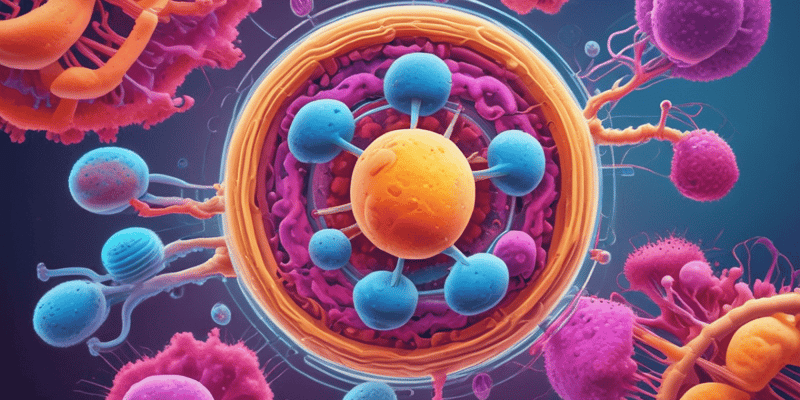18 Questions
Which of the following is a key regulator that ensures G1 is completed prior to the start of S phase?
Tumor suppressors and CDK inhibitors
What is the main consequence of a mutation in the retinoblastoma (RB) protein?
The cell is not stopped in G1 and continues unregulated progression through the cell cycle
Which of the following is a direct cause of some cancers due to unregulated expression?
Cyclins or CDKs
What is the main function of the CDK pathway in relation to tumor growth?
The CDK pathway is deregulated in most human tumors
Which of the following is a key role of tumor suppressor proteins in the cell cycle?
To halt cell cycle progression within G1 when needed
What is the main consequence of mutations in tumor suppressor genes?
The cell is able to progress through the cell cycle at inappropriate times
Which of the following is a key function of the G2 checkpoint in the cell cycle?
To ensure DNA replication is complete before mitosis begins
What is the role of CDK inhibitors at the G2 checkpoint?
They inhibit the activity of CDK1, preventing entry into mitosis
Which of the following is a key difference between the INK4A and CIP/KIP families of CDK inhibitors?
INK4A inhibitors target CDK4 and CDK6, while CIP/KIP inhibitors target CDK2
How does the loss of p53 function contribute to unregulated cell cycle progression in cancer?
p53 mutations prevent the activation of CDK inhibitors like p21
What is the primary role of cyclin-dependent kinases (CDKs) in the cell cycle?
To associate with and activate specific cyclins, driving cell cycle progression
How do cyclin-CDK complexes regulate the cell cycle?
They phosphorylate and activate target proteins to drive cell cycle progression
What is the primary function of cyclin-dependent kinases (CDKs) in the cell cycle?
To phosphorylate specific proteins and regulate their activity
Which of the following is a key mechanism by which the cell cycle is regulated?
Specific proteolytic degradation of proteins by the ubiquitin-proteasome system
What is the primary role of cyclin-CDK complexes in the cell cycle?
To phosphorylate specific proteins and regulate their activity
Which of the following is a key function of cyclin-dependent kinase inhibitors (CKIs) in the cell cycle?
To dephosphorylate and inactivate CDKs, thereby halting cell cycle progression
What is the primary function of the M phase in the cell cycle?
To distribute the duplicated genetic material equally to the two daughter cells
Which of the following is a key regulatory mechanism that ensures the proper progression of the cell cycle?
Phosphorylation of specific proteins by CDKs and their dephosphorylation by phosphatases
Study Notes
Cell Cycle Regulation
- More than 50% of human cancers show p53 mutations, leading to unregulated cell cycle progression.
- p53 mutations can cause cells to bypass the G1 checkpoint and enter the S phase without proper DNA replication.
Cyclin-Dependent Kinase Inhibitors
- There are two classes of cyclin-dependent kinase inhibitors: INK4A and CIP/KIP families.
- INK4A family members inhibit D-type cyclins from associating with and activating CDK4 and CDK6.
- CIP/KIP family members, including p21, inhibit CDK2 kinases.
G2 Checkpoint
- The G2 checkpoint occurs after the S phase and before the initiation of mitosis.
- The G2 checkpoint ensures the integrity of the genome by preventing nuclear division (mitosis) before complete DNA duplication during the S phase.
- CDK inhibitors and phosphatases function at the G2 checkpoint to regulate cell cycle progression.
Cell Cycle Regulation
- Cell division is a highly regulated process that ensures the proper division of a cell into two daughter cells.
- Cell proliferation is necessary for growth, development, and regeneration of eukaryotic organisms, but it can also lead to cancer.
- The cell cycle combines DNA replication with chromosomal segregation in an oscillatory manner.
Cell Cycle Phases
- Interphase is the period between two mitotic divisions, consisting of the G1, S, and G2 phases.
- M phase corresponds to the visible mitosis, where the duplicated genetic material is distributed equally to each daughter cell.
Cell Cycle Control
- Cell cycle progression is controlled by two regulatory processes: phosphorylation of specific proteins by CDKs and their dephosphorylation by phosphatases, and specific proteolytic degradation by the ubiquitin-proteasome system.
- Cell cycle-related genes are often mutated in tumors, leading to unregulated cell proliferation and tumor growth.
Tumor Suppressors and CDK Pathway
- Tumor suppressor proteins, such as p53 and retinoblastoma (RB) protein, halt cell cycle progression at the G1 checkpoint when DNA is damaged or growth is not needed.
- Mutated versions of tumor suppressor genes encode proteins that permit cell cycle progression at inappropriate times, leading to cancer.
- Cancer cells often show mutations of tumor suppressor genes, such as RB, which normally halts cells in the G1 phase of the cell cycle.
This quiz covers the regulation of the cell cycle, including the process of cell division and the necessity of cell proliferation for growth and development. It also discusses the importance of eukaryotic somatic cells doubling their mass and equally apportioning components to daughter cells.
Make Your Own Quizzes and Flashcards
Convert your notes into interactive study material.
Get started for free



